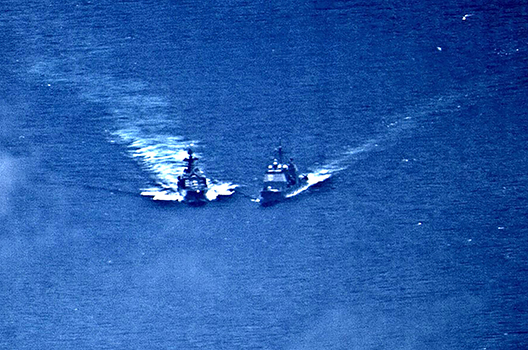The near collision of US and Russian warships in the Philippine Sea on June 7 is just the latest close call between the two nations’ militaries that have increasingly found themselves in tense encounters around the globe. While a crisis was averted, the next time may be different.
Barry Pavel, senior vice president, Arnold Kanter chair and director of the Scowcroft Center for Strategy and Security at the Atlantic Council, said with close calls like the one on June 7 “the risks of escalation are very significant.”
The actions of the Russian destroyer “is close to the boundaries of normal maritime rules” and may not always end with a near-miss, he warned.
“This is just the latest example of provocative military behavior by Russia against the United States and NATO that has become standard operating procedure since [Russia’s] 2014 aggression against Ukraine,” according to Alexander Vershbow, a distinguished fellow at the Atlantic Council’s Scowcroft Center for Strategy and Security, and a former US ambassador to Russia and deputy secretary general of NATO.
Pavel noted that the June 7 incident is significant for taking place in the Asia-Pacific. Russia acted this way “to send a signal: ‘we have reach,’” he said. He added, however, that this is purely symbolic because Russia doesn’t “have the sustainment and power projection capabilities that the United States does” in the Pacific, but they are harassing the United States to send a message.
According to the US Navy, the Russian destroyer Udaloy I came within fifty to one hundred feet of the USS Chancellorsville, causing the US ship to maneuver to avoid a collision. The US Navy’s Twitter account recounted that “Russian destroyer Udaloy I made an unsafe and unprofessional approach in the Philippine Sea.”
BREAKING: #USNavy has released video of #USSChancellorsville being forced to maneuver to avoid collision, after #Russian destroyer Udaloy I made an unsafe and unprofessional approach in the Phillippine Sea, June 7th. (1/2) pic.twitter.com/HpmAMtYraS
— U.S. Navy (@USNavy) June 7, 2019
According to US Navy spokesman Cdr. Clayton Doss, the Russian destroyer “made an unsafe maneuver against the USS Chancellorsville,” which forced “Chancellorsville to execute all engines back full and to maneuver to avoid collision.” Russian officials disputed this account and argued that it was the US vessel that made unexpected actions causing the near miss.
Vershbow said that “the Russians—as usual—tried to shift the blame to the United States.” A closer look at the video footage, however, “makes clear that it was the Russians that precipitated the near-collision,” Vershbow maintained.
US Acting Defense Secretary Patrick M. Shanahan said on June 7 that the United States will issue a formal protest to Moscow over the incident. “Of course, we’ll demarche them,” he said. These actions by the Russian military, he continued, “will not deter us from conducting our operations.”
The incident follows increasing close calls and tense interactions between Russian and US military personnel. In May, US stealth aircraft intercepted Russian bombers and fighter jets on two different occasions for flying into the Alaskan Air Defense Identification Zone, which covers around 200 miles off of Alaska’s western coast.
On June 5, Russian aircraft intercept a US Poseidon aircraft over the Mediterranean Sea. US officials contended that the US aircraft was legally flying over international air space when the Russian plane came within 150 feet of the US aircraft. Russian officials denied any wrongdoing by their aircraft.
Michael Carpenter, a nonresident senior fellow with the Atlantic Council’s Eurasia Center and a former deputy US assistant secretary of defense with responsibility for Russia, Ukraine, Eurasia, the Balkans, and Conventional Arms Control, argued that the incident “shouldn’t surprise anyone” as “Russia regularly engages in unsafe, unprofessional passes in the air and sea.”
“The Russian military has a clear mandate to intimidate whenever it can, hoping the US will back down,” Carpenter wrote on Twitter.
The June 7 incident fits into Moscow’s larger geopolitical strategy to “play a very significant spoiler role opposing anything the United States does,” according to Pavel. “This is part of a global ideological struggle of authoritarians against democratic countries,” he said, adding that “this is a geopolitical competition that is underway; the military is a tool in that.”
Pavel explained that Russian military forces have been harassing US and NATO allied military forces in Europe for years. “They have used military forces and military policy statements to rattle NATO. They have their fighter aircraft turning off their transponders near civilian airlines in Northern Europe,” he said.
David A. Wemer is assistant director, editorial, at the Atlantic Council. Follow him on Twitter @DavidAWemer.
Image: A surveillance photo shows the Russian naval destroyer Udaloy making what the US Navy describes as an unsafe maneuver against the Ticonderoga-class guided-missile cruiser USS Chancellorsville in the Philippine Sea June 7, 2019. (US Navy/Handout via REUTERS)

